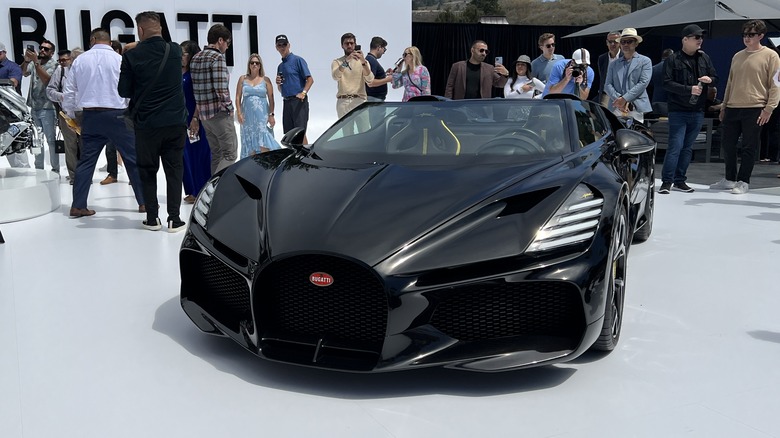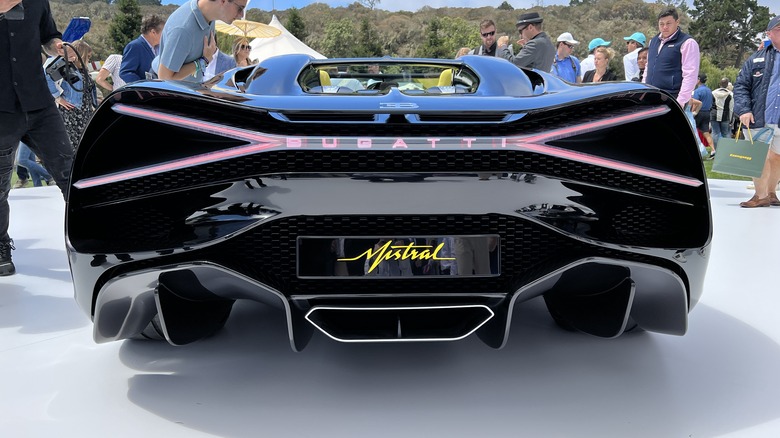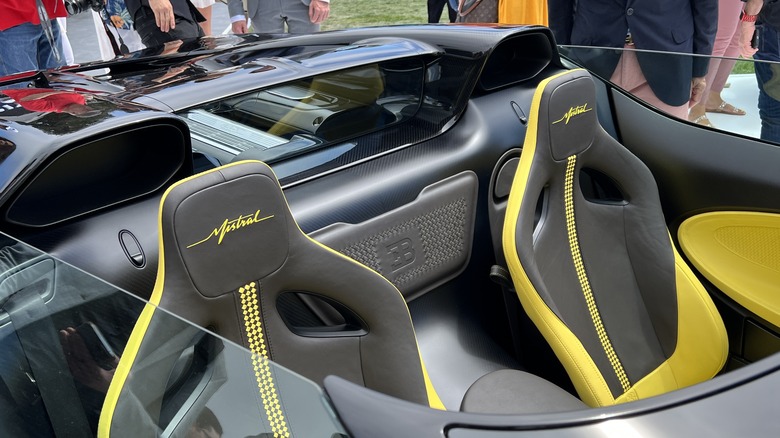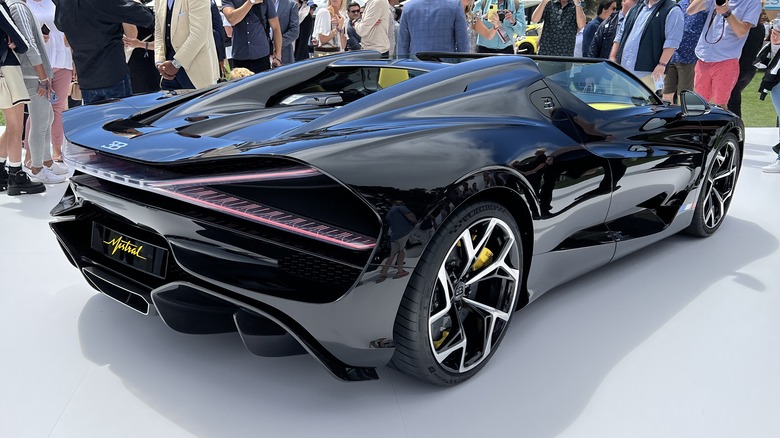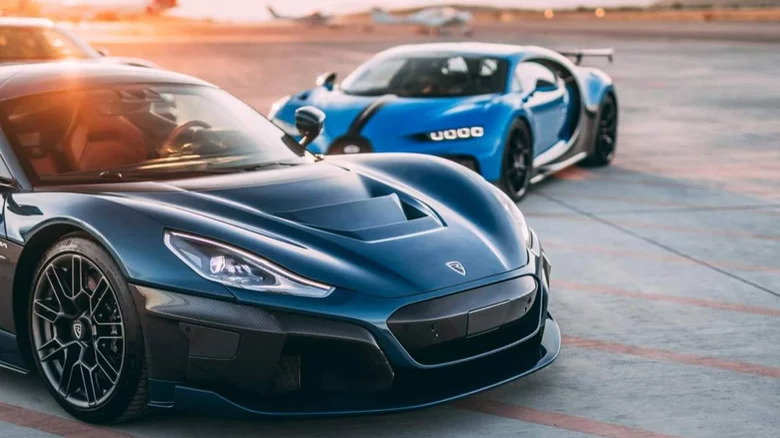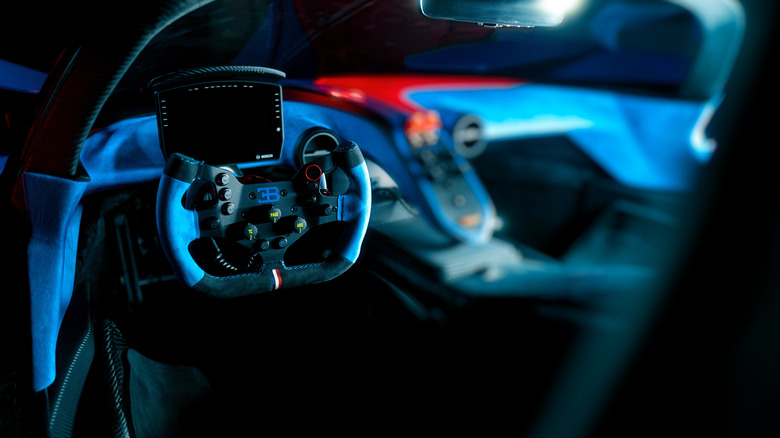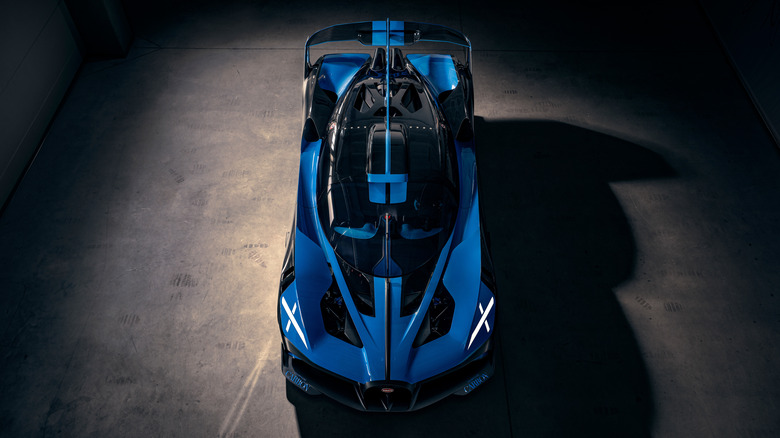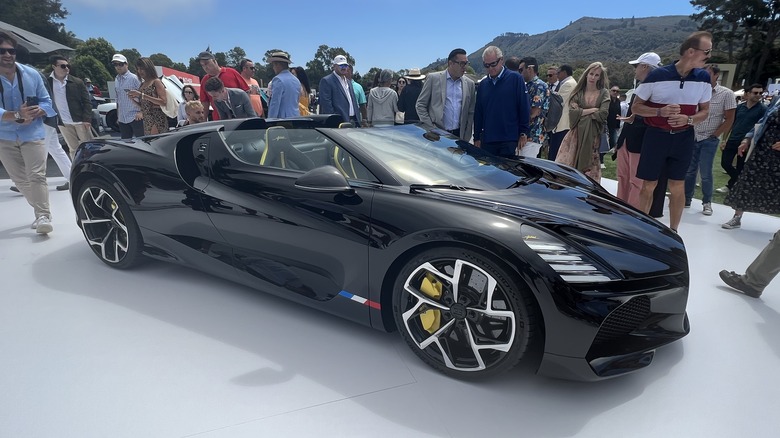The Electric Bugatti Will 'Reinvent The Hypercar' — Exclusive Interview
The first all-electric Bugatti is a case of when, not if. Though the automaker may be sitting pretty on 99 confirmed sales of its striking W16 Mistral hypercar — no small achievement at a lavish $5 million apiece — work is already underway on its first hybrid and then entirely electric successors, as the legendary sixteen cylinder gas engine slips into, well, legend.
Handiwork of the Bugatti Rimac hypercar hook-up was announced in mid-2021, and details of the new Bugatti range are being held close to the automaker's chest. Speaking at Monterey Car Week in California, Frank Heyl, Deputy Design Director at Bugatti told SlashGear he's "already head over heels into the development" of what comes next, though unsurprisingly wouldn't spill specifications or specifics about the first Bugatti EV.
Nonetheless, when it comes to what to expect from the new era of hypercars, you may find some of your assumptions about electric super-performance are upended.
Every one of those $5 million counts
Heyl has, you won't be surprised to hear, been kept busy in the development of the W16 Mistral. The shapely open-top is a farewell to the 16-cylinder engine which has distinguished Bugatti since the Veyron, requiring a whole new monocoque in order to successfully lose the roof without compromising on structural stiffness.
It's also, less conspicuously, an example of Bugatti's development cost strategy at work. Though the scale of the sticker price may differ significantly from, say, how many Civics that Honda needs to sell in order to break even on its R&D, the W16 Mistral couldn't be as cavalier with costs as its avant-garde aesthetic might imply. Bugatti customers may be willing to dip into their cash reserves for a slice of limited-production automotive history, but the automaker itself won't countenance a vehicle that doesn't cover its own creation.
"People always think, okay, we sell cars at five million," Heyl says. "But actually, if you have so few units to recover your investment, these projects are calculated with a very sharp pencil, believe me."
Form follows performance
One of the biggest challenges automakers — particularly high-end ones like Bugatti — have encountered with the transition to electrification has been weight. After all, though electric motors can be lighter than a multi-cylinder gas engine when viewed in isolation, they also need a sizable battery array in order to power them. Hiding the impact of that heft is one thing in an SUV, or a big luxury sedan. In a performance car expected to be nimble, it's quite another.
Bugatti, ironically, may be among the better-placed out there to get that right. After all, it's well used to needing to balance weight without sacrificing the creature-comforts that owners expect from their hyper-luxury GT.
From a design standpoint, Heyl explains, it comes down to making maximum use of what you allow onto the car. "Form follows performance is our credo — we don't put any air intakes anywhere that don't function. It's all there for a reason," he explains. "And so, this is a basic, lightweight philosophy: everything, if you can get a double or triple function into it, you have one component for three uses, you don't need three components. So you make it lighter that way."
Everybody be cool
On the W16 Mistral, the first roadster in the Chiron era, that means features like cooling air snorkels above the driver and passenger's heads, which also double as roll protection each capable of supporting several times the weight of a flipped car. When you're dealing with a vehicle with a roughly 260 miles per hour top speed, and the 1,578 horsepower engine borrowed from the record-setting Chiron Super Sport 300+, cooling and aero are instrumental in overall vehicle design, not afterthoughts to a clean silhouette.
That's a fact that may end up leading to some surprise when the first electric Bugatti arrives, and as the requirements of drivetrain cooling, in particular, have their impact on design.
"Many people think, 'oh, electric cars don't need any radiators.' That's not the case," Heyl says. In fact, it comes down to the difference between the temperature of the cooling liquid in the drivetrain and that of the ambient air around the vehicle. In a combustion engine, that delta could be 180 degrees Fahrenheit. For a battery-powered EV, meanwhile, the difference between drivetrain and ambient could be as little as a fifth of that.
The lie of EVs
Though you might think that's an advantage, for a performance car that needs to more effectively shed heat using ambient air, it's actually a bigger challenge for the EV. "If you have a hotter cooling liquid, and you have ambient air and you have a radiator, pushing the ambient air through, you can knock off a lot more temperature in relation," Heyl explains. With a smaller delta, in contrast, performance EVs actually need bigger radiator surfaces.
"If we're speaking about mass transportation, little tiny electric cars, no," Heyl points out. "Everybody talks about 'oh, electric cars can be completely clean and have no intake,' but I find that a lie, because if you look at some of the electric cars, they also have a cooling intake just down below the number plate. And then just everything on top is clean. Okay, there's no BMW kidney, or the BMW kidney is blanked out, but underneath there's still a vent."
For electric hypercars, then, the cooling challenges will be even more considerable. What's certain, though, is that the location of the vents, scoops, radiators, and grilles will diverge sharply from what we've seen on cars like the W16 Mistral. That, Heyl says, is also where one of electrification's big advantages weighs in.
The hypercar future is distributed
"Our car tells a story just by looking at it," the designer says. "This is there because of that; this is there because... like, it's all tied in, not just a pretty thing. It's a function, right? I don't even need any kind of styling on it, because the thing is somehow integral to itself. And so, if you ask me about how does the future, and electric, and so on, change that, there still is going to have to be cooling and there is still going to have to be intakes and exits, and the air is still the same regardless of what source of power you have."
The air may be the same, but where it needs to reach will vary dramatically. Unlike in a W16 Mistral, or a Chiron, where the engine is physically behind the driver and power is routed to the front wheels mechanically, in an all-wheel-drive EV there'll likely be electric motors at the front and rear. Each will need to take advantage of a new breed of more distributed cooling, as will the battery pack almost certainly slung low, under the cabin.
Looking to motorsports
For Heyl, part of the inspiration is what's been going on in motorsports, where nailing the advanced aerodynamics has long helped make the difference between a podium finish or not. "The next step is, we're not streaming only around the car, we're streaming through the car," he explains, "so through-flow, controlling through-flow."
Those airflow routes will help Bugatti unlock things like greater downforce — as we've seen the automaker explore with the wild, 311 mph track-only Bolide — but the designer can also use them to guide cooling air to where exactly it needs to reach each distributed component in the overall electric drivetrain.
"[With W16 Mistral] we have, let's say, one central power source — which is the combustion engine — and then there's a gearbox and we distribute the power to all four wheels. So you are, since many years, locked into this kind of architecture, right?" Heyl explains. "Now comes electrification. And you don't need to mechanically still propel the front wheels, you can do it just on wire and there's an electric separate motor, and you can package that differently. Run front diffusers, really big exits out the sides. Things start to get moving, and there's potential being offered."
Reinventing the hypercar
Just how all this might shape the new Bugatti hybrids and fully-electric hypercars remains to be seen. Rimac founder Mate Rimac said last year that, though it would be easiest just to slap a Bugatti badge onto a reskinned version of his own company's Rivera, that sort of recycling wasn't the plan. Though there'll be shared technologies created at the new research and development Rimac Campus set to open in 2023, the two nameplates will continue to operate as independent brands.
Similarly, the gas-electric Bugatti won't just be the Chiron with the W16 engine swapped out for a hybridized version. Instead, Mate Rimac confirmed, it would be completely new as the brand transitions into full electric.
It's clear that strategy plays right into Heyl's preferred approach, too. "I'm just fascinated by this stuff," the designer concluded. "And I think we have a chance now, to break up on some of the conventions, and to reinvent the hypercar. I'm just super happy to be in the middle of it all."
